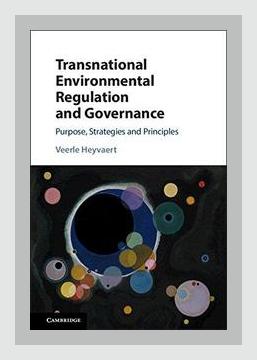Business Law and EthicsEnvironmental Law
Introduction
In “Transnational Environmental Regulation and Governance: Purpose, Strategies and Principles,” Veerle Heyvaert delves deep into the complexities of modern environmental regulation within a global context. As environmental challenges increasingly transcend national boundaries, Heyvaert explores the need for, and the implementation of, transnational governance frameworks that can effectively address such issues. This summary encapsulates the main themes, strategies, principles, and actionable insights proposed in the book, structured around key sections.
1. Purpose and Necessity of Transnational Environmental Regulation
Main Point:
Heyvaert begins by elucidating why traditional, nation-state-based regulatory mechanisms are insufficient for tackling transboundary environmental problems such as climate change, ocean pollution, and biodiversity loss.
Concrete Examples:
– Climate Change: Heyvaert discusses the inadequacy of national policies in curbing greenhouse gas emissions, which necessitates global agreements like the Paris Agreement.
– Ocean Pollution: The problem of plastic waste in the oceans, sourced from multiple countries, highlights the need for coordinated international action.
Action Step:
– Individual: Advocate for and support international environmental agreements through petitions and public campaigns.
– Organization: Develop and participate in international coalitions or partnerships aimed at environmental protection (e.g., cross-border waste management initiatives).
2. Strategies for Effective Transnational Environmental Governance
Main Point:
Heyvaert identifies several strategies that can enhance the effectiveness of transnational environmental governance, focusing on cooperation, harmonization, and innovative regulatory techniques.
Concrete Examples:
– Harmonization: The alignment of environmental standards and policies across countries to avoid regulatory competition and “pollution havens.”
– Example: The European Union’s harmonized regulations on emissions standards for vehicles.
– Cooperative Frameworks: Establishing multilateral environmental agreements (MEAs) where countries commit to collective environmental goals.
– Example: The Montreal Protocol on Substances that Deplete the Ozone Layer.
Action Step:
– Individual: Support and adhere to international standards in consumer choices (e.g., choosing products adhering to the EU’s eco-label).
– Organization: Align corporate policies with international environmental standards and participate in initiatives like the Global Reporting Initiative (GRI) for sustainability.
3. Principles Guiding Transnational Environmental Regulation
Main Point:
Heyvaert emphasizes the importance of foundational principles such as precaution, sustainability, and justice in guiding transnational regulatory efforts.
Concrete Examples:
– Precautionary Principle: Acting to prevent environmental harm when there is scientific uncertainty.
– Example: The EU’s ban on certain chemicals in agricultural products based on precautionary measures.
– Sustainability Principle: Ensuring that environmental regulation supports long-term ecological balance.
– Example: The integration of sustainability criteria into the World Bank’s lending policies for development projects.
Action Step:
– Individual: Practice the precautionary principle by opting for organic products or reducing the use of potentially harmful chemicals.
– Organization: Incorporate sustainability metrics into business operations and strategy, using guidelines from institutions like the United Nations Global Compact.
4. Challenges and Barriers to Effective Transnational Environmental Governance
Main Point:
Heyvaert discusses several challenges impeding the implementation of effective transnational governance, such as varying national interests, enforcement issues, and socioeconomic disparities.
Concrete Examples:
– National Interests: Countries prioritizing economic growth over environmental protection.
– Example: Reluctance of some nations to commit to emissions reduction targets fearing economic slowdown.
– Enforcement Issues: Difficulty in monitoring and sanctioning non-compliance across borders.
– Example: The challenge of enforcing international fishing quotas.
Action Step:
– Individual: Stay informed about the environmental policies and compliance records of different countries and businesses.
– Organization: Support transparent reporting and third-party audits to ensure compliance with international environmental standards.
5. Role of Non-State Actors in Transnational Environmental Governance
Main Point:
Non-state actors, including NGOs, corporations, and scientific communities, play a critical role in shaping transnational environmental governance.
Concrete Examples:
– NGOs: Advocacy and watchdog functions to hold governments and corporations accountable.
– Example: Greenpeace’s efforts in campaigning against deforestation and ocean pollution.
– Corporations: Adoption of corporate social responsibility (CSR) frameworks to complement governmental regulations.
– Example: The role of multinational companies in reducing their carbon footprint beyond local laws through initiatives like the Carbon Disclosure Project (CDP).
Action Step:
– Individual: Support NGOs and advocacy groups working on environmental issues through donations, volunteering, or activism.
– Organization: Develop and implement robust CSR policies that align with global environmental standards and practices.
6. Innovative Regulatory Instruments and Mechanisms
Main Point:
Heyvaert explores various innovative regulatory instruments that can enhance the flexibility and responsiveness of transnational environmental governance.
Concrete Examples:
– Market-based Mechanisms: Utilizing economic incentives to achieve environmental outcomes.
– Example: The European Emissions Trading System (ETS) which allows companies to trade emissions credits.
– Information-based Regulation: Leveraging data transparency and public disclosure to drive compliance.
– Example: Pollutant Release and Transfer Registers (PRTRs) that compel businesses to disclose their emissions.
Action Step:
– Individual: Use platforms that provide information on the environmental impact of products and companies, like the Environmental Working Group’s (EWG) database.
– Organization: Adopt market-based mechanisms such as internal carbon pricing to reduce greenhouse gas emissions and improve sustainability.
7. Case Studies and Comparative Analyses
Main Point:
Heyvaert uses case studies and comparative analyses to illustrate the successes and failures of various transnational environmental governance frameworks.
Concrete Examples:
– Case Study: Analysis of the Basel Convention’s effectiveness in controlling hazardous waste transboundary movements.
– Comparative Analysis: Comparing the regulatory approaches of the EU and the US in addressing electronic waste (e-waste).
Action Step:
– Individual: Advocate for the adoption of successful regulatory frameworks from other regions by engaging with policymakers.
– Organization: Conduct internal analyses comparing global best practices and adapt successful strategies to local operations.
Conclusion
In “Transnational Environmental Regulation and Governance: Purpose, Strategies and Principles,” Veerle Heyvaert provides a comprehensive analysis of the exigencies and dynamics of regulating environmental issues that go beyond national borders. By integrating practical examples and actionable insights, the book offers a robust framework for individuals, organizations, and policymakers to contribute effectively to transnational environmental governance. The strategies and principles outlined by Heyvaert not only underscore the complexity of global environmental issues but also provide a pathway for collective action and improved regulatory frameworks.
